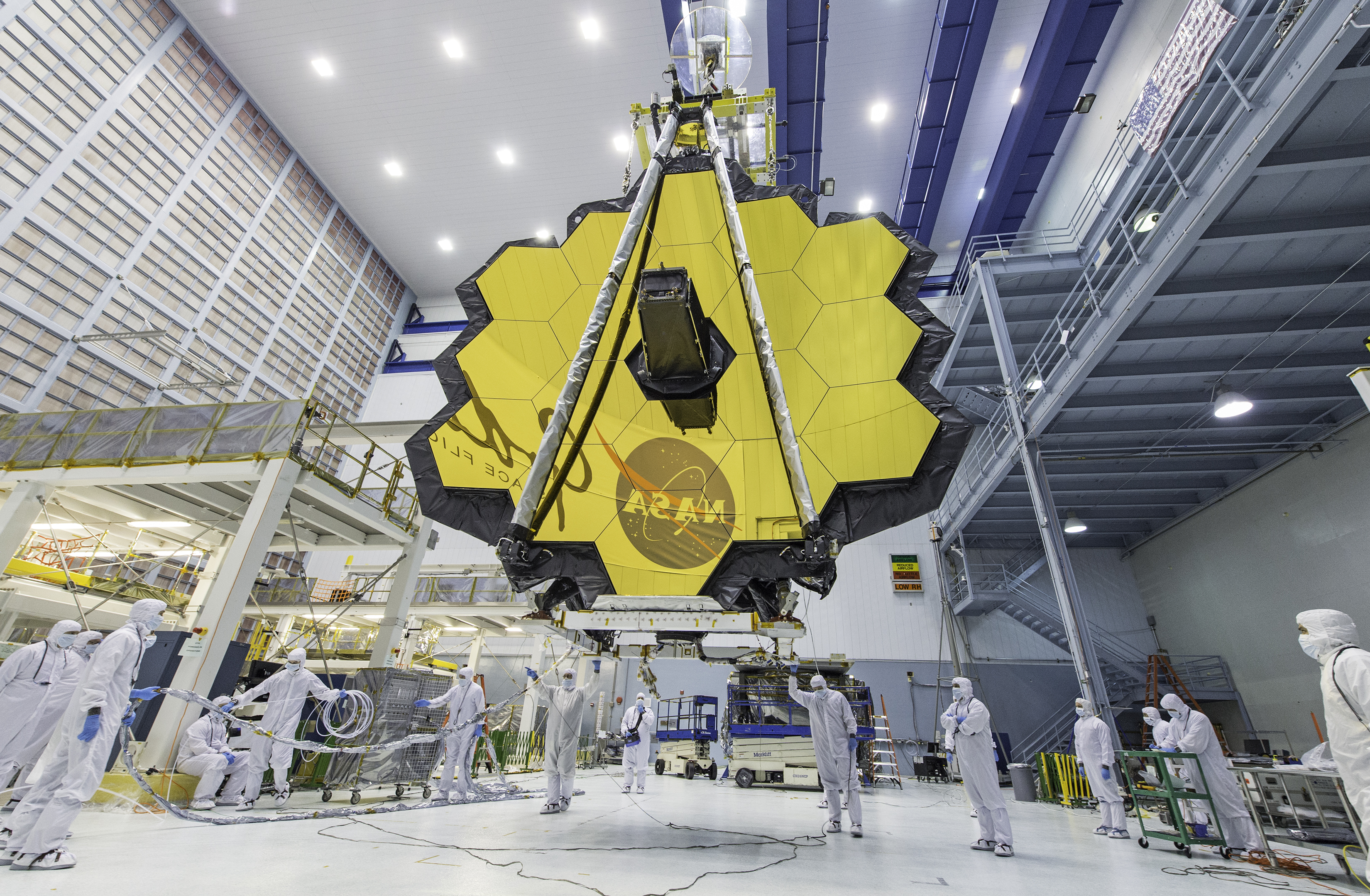 |
| From NASA, Public Domain |
NASA, the European Space Agency, and the Canadian Space Agency developed the James Webb Space Telescope in collaboration. It is intended to succeed NASA's flagship Hubble Space Telescope. The James Webb Space Telescope is slated to launch on Ariane flight VA256 no earlier than Christmas 2021.
The telescope will beat Hubble's infrared resolution and sensitivity and will enable a broad range of astronomical and cosmological investigations, including the observation of some of the universe's most distant events and objects, such as the formation of the first galaxies, and detailed atmospheric characterization of potentially habitable exoplanets.
The James Webb Space Telescope's development began in 1996 with a $500 million budget and an early target launch date of 2007. Numerous delays and cost overruns occurred during the project's development, including a major redesign in 2005, a ripped sunshield during a practice deployment, a recommendation from an independent review board, the COVID-19 pandemic, issues with the Ariane 5 rocket and the telescope itself, and communication issues between the telescope and the launch vehicle. Concerns expressed by scientists and engineers engaged in the project regarding the telescope's launch and deployment have been amply reported.
 |
| Concept Photo of the James Webb Space Telescope in space. From NASA, Public Domain |
The James Webb Space Telescope's construction was finished in late 2016, and an extended testing phase began immediately thereafter.
NASA announced on December 21st, 2021, that the James Webb Space Telescope will launch from Kourou, French Guiana, on the northeastern coast of South America, at 12:20 UTC on Christmas Day using an Ariane 5 launch vehicle.
How Far Away Will The James Webb Space Telescope Travel?
The James Webb Space Telescope will be situated around 930,000 miles outside Earth's orbit, at the Earth–Sun L2 (Lagrange point). By comparison, Hubble circles 340 miles above the Earth's surface, whereas the Moon is almost 250,000 miles away.
With the spacecraft available at the telescope's design and construction stage, this distance will make post-launch maintenance or upgrading of the James Webb Space Telescope components nearly impossible.
 |
| James Webb Space Telescope in space. NASA, Public Domain. |
Objects at this Lagrange point can orbit the Sun in lockstep with the Earth, allowing the telescope to keep a roughly constant distance and orientation of the single heatshield and Bus toward the earth and sun, blocking heat and light from the Sun and Earth and maintaining communications. This method will maintain the spacecraft's temperature below 370 degrees Fahrenheit, which is required for infrared studies.
What Is The James Webb Space Telescope Going To Study?
The James Webb Space Telescope's four primary objectives are as follows:
- To look for light emitted by the earliest stars and galaxies.
- To conduct research on the formation of galaxies.
- To gain a better understanding of how stars and planetary systems form.
- To conduct research on planetary systems and life's origins.
These objectives will be performed by observing the universe in near-infrared light rather than just visible light. As a result, the James Webb Space Telescope's equipment will not be able to detect visible or ultraviolet light in the same way as the Hubble Telescope can, but instead will have a considerably better capability for infrared astronomy.
The James Webb Space Telescope will be sensitive to wavelengths ranging from 0.6 micrometres (orange light) to 28 micrometres (deep infrared radiation).
The James Webb Space Telescope, using this technology, will be able to observe far more and much older stars and galaxies than the Hubble Space Telescope ever could.
The farther an item is from observers, the younger it seems. This is because its light has taken longer to reach them. Due to the expansion of the cosmos, light becomes red-shifted as it travels, making things at great distances easier to see when viewed in the infrared. The infrared capabilities of the James Webb Space Telescope are projected to enable it to peer back in time to the birth of galaxies.
Observing in the infrared spectrum is critical because of the cosmic redshift and the fact that infrared light penetrates better through dust and gas. This enables viewing of objects that are fainter and colder.
Due to the substantial absorption of the majority of infrared by water vapor and carbon dioxide in the Earth's atmosphere, ground-based infrared astronomy is confined to narrow wavelength ranges where the atmosphere absorbs less strongly. Additionally, the atmosphere itself emits infrared radiation, frequently overpowering the light emitted by the object being seen. This highlights the need of using a space telescope for infrared observations.
Why Is It Called The James Webb Space Telescope?
The telescope was originally named the Next Generation Space Telescope. However, it was renamed to shine light on the leadership of James E. Webb, who oversaw NASA in the 1960s during the Space Race.
 |
| Photo of James Webb. NASA, Public Domain. |
From 1949 until 1952, Webb served as Undersecretary of State. From February 14, 1961, through October 7, 1968, he served as NASA's second administrator. Webb led NASA from the Kennedy administration's inception through the conclusion of the Johnson administration, monitoring each of the Mercury and Gemini projects' vital first crewed missions until days before the launch of the first Apollo mission. He was also involved in the Apollo 1 fire.
Webb accepted President John F. Kennedy's nomination as Administrator of NASA on February 14, 1961, succeeding temporary director Hugh L. Dryden, Deputy Administrator. Webb oversaw NASA's achievement of Kennedy's aim of landing an American on the Moon by the end of the 1960s via the Apollo program.
Webb lobbied Congress for NASA funds for seven years, beginning with Kennedy's May 25, 1961, proclamation of the objective of a manned lunar landing. As a long-time Washington insider, he was able to secure continuous support and funding for Apollo with the backing of President Lyndon B. Johnson.

0 Comments